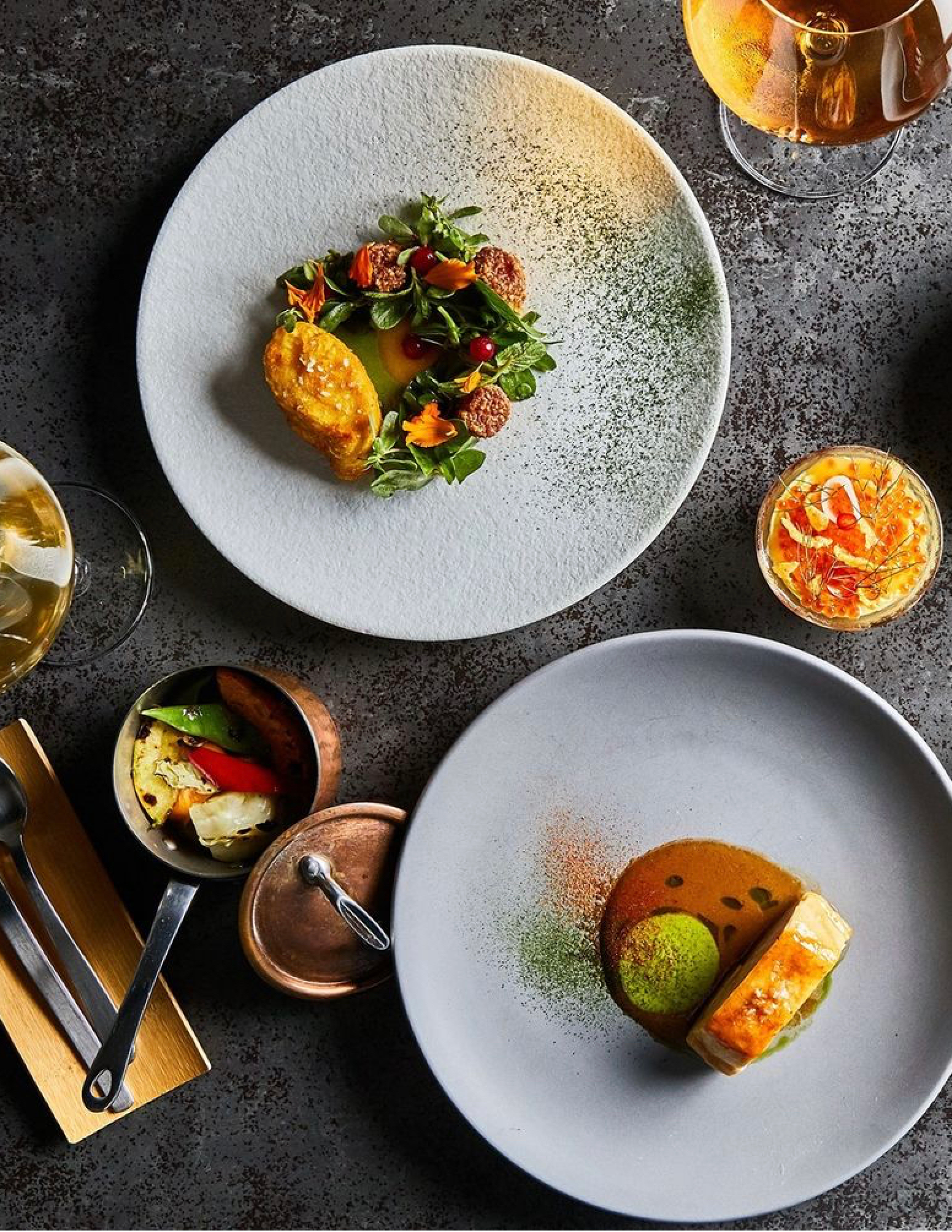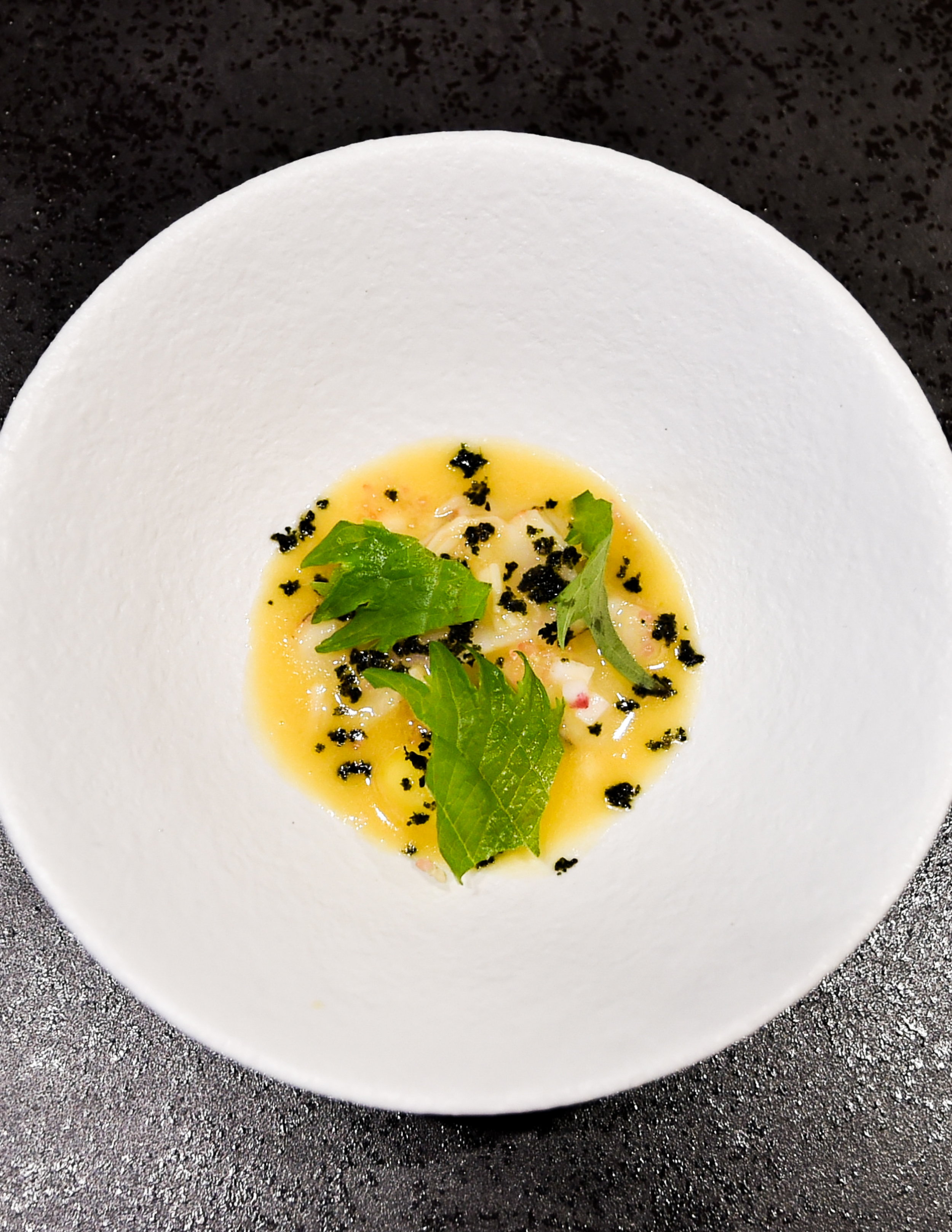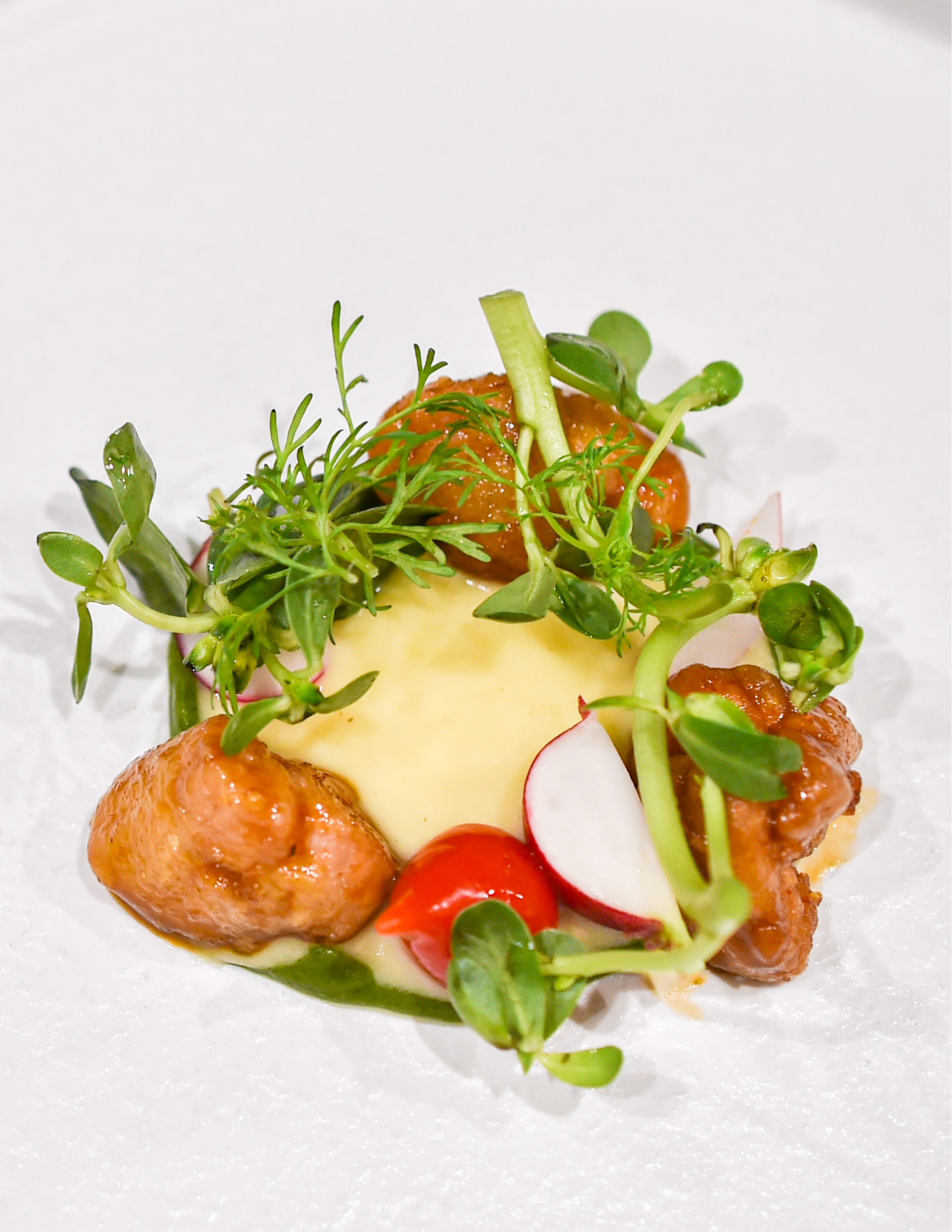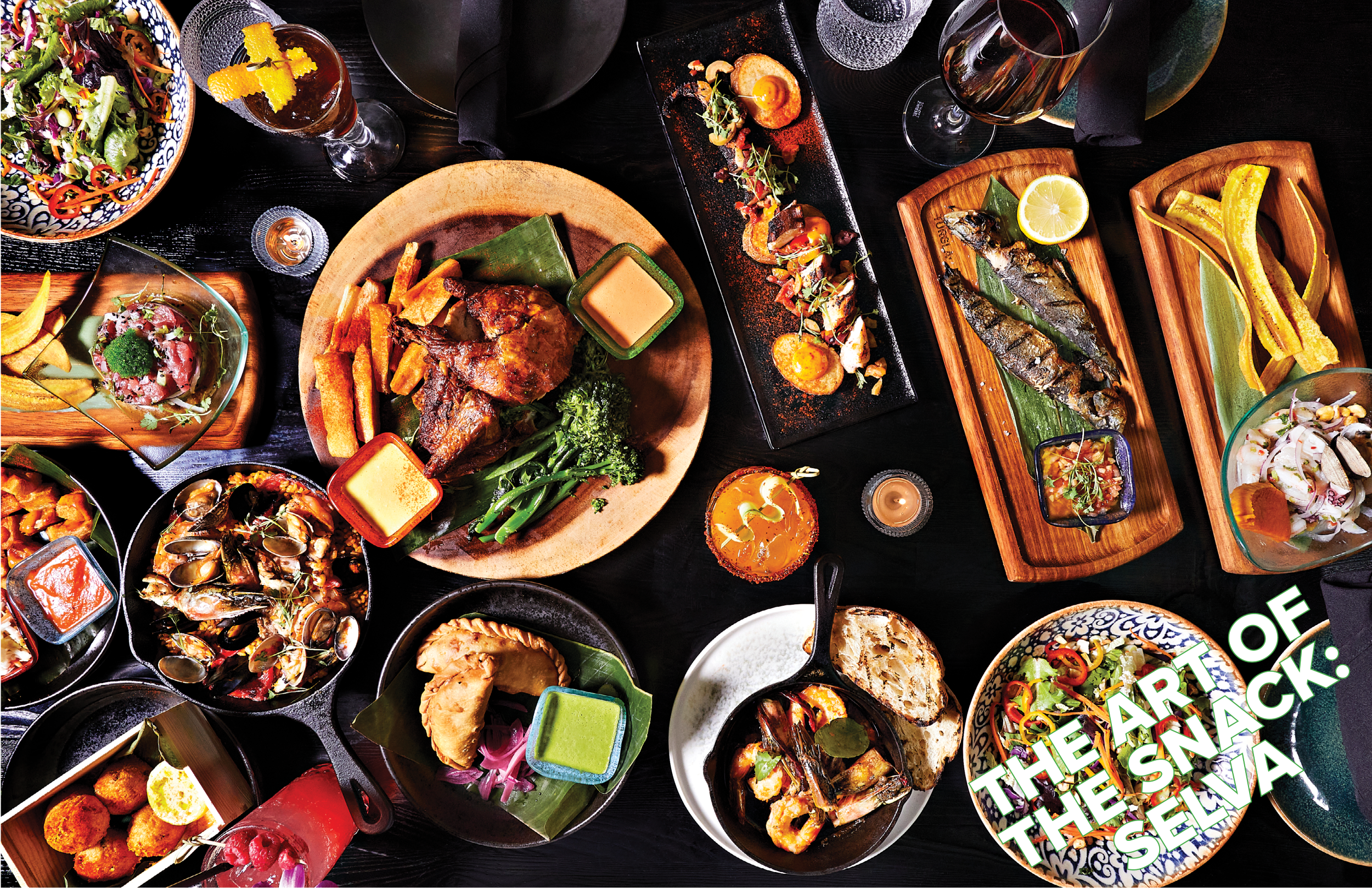In this month's The Art of the Snack, we're heading down to NYC's LES for an epic meal! We had the opportunity to sit down with Chef/Founder Nahid Ahmed and Chef/Partner Arjuna Bull of Luthun. Both of these founders have been friends and clearly have a passion to bring a culinary experience to each plate that is served to you! We also talk about the beverage program with Sommelier Jahdea Gildin. We talk with this team to find out about their backgrounds, how they came together and what we can expect when dining there. With an open kitchen as well as tasting menus, we know that this is going to be a restaurant that we will find ourselves coming back to again and again!
ATHLEISURE MAG: When did Luthun open?
CHEF NAHID AHMED: Luthun opened on July 25th, 2019 in the East Village.
AM: Chef Nahid Ahmed and Chef Arjuna Bull, please share your backgrounds and culinary journeys that brought you to Luthun?
CHEF NA: My culinary journey began when I studied at a culinary school in Lausanne, Switzerland in the early 90s. During the program, I had an internship with Chef Gray Kunz, who became one of my mentors, at Lespinasse in New York City. After returning to Europe to finish my school, I worked for another mentor of mine, Swiss Chef Philippe Rochat at his Restaurant de L'Hôtel de Ville in Crissier, Switzerland. I came back to Lespinasse, where I worked for a few years under Gray Kunz and left around the same time he did. He connected me with Thomas Keller at The French Laundry where I worked for a while but not being a big fan of Napa Valley at the time, I went back to Europe and Philippe Rochat’s restaurant again, which has held 3 Michelin stars for over 50 years. After that, I had a chance to work at El Bulli in Spain for some time, then at The Fat Duck in London where I moved to be closer to my family. While there, Gray Kunz calledme and said he was opening Café Gray in New York so I went to help him and met chef Arjuna ‘AJ’ Bull who also worked there. I worked there with Gray until it closed, then at the Plaza Hotel for the reopening of the Oak Room but it was not a fit for me and I started thinking about opening my own place. Then in 2011, I got a chance to open Respite in Midtown. I brought in Chef AJ and the two of us helped open this little place. It was not ours, but we ran everything. It was a hole in the wall and we had so much fun there. That’s where the whole idea of Luthun came to my mind. I wanted to open my own restaurant, to do my own things, to cook and create my own cuisine. So, after that, I worked at bunch of other places, I did pop-up dinners all over, while working on funding. And then I finally opened Luthun in 2019, my long awaited dream: Luthun restaurant in New York City.
CHEF ARJUNA ‘AJ’ BULL: I went to culinary school in Miami and graduated from Johnson & Wales in 2000. I did my externship at The Fontainebleau Hilton Resort; it was good experience working in all different departments. But then I took a quick vacation to New York and I fell in love with the industry, so right away I moved here and started working at a lot of different places. One of the biggest highlights was when I got to work with Chef Nahid at Café Gray, where I worked for a couple years with him. It took me to the next level; experiencing Michelin food changed my whole vision and goals. I did a bunch of pop-up restaurants with Chef Nahid. In the meantime, I had a couple other executive chef jobs, just to get some British experience since I was born in England. It's been a crazy journey here in New York, but so much experience. And finally, we had the opportunity and found an investor. We found a cool space in the East Village and here we are at Luthun.
AM: Why did both of you want to come together to create Luthun?
CHEF NA: When I decided to open my restaurant Luthun, it was because I'm very picky about my food. I didn’t want to cook food like that of my mentors or restaurants I’d worked at. So when I set out to create my cuisine, I asked myself what kind of cuisine? It had to come from me and who I am, what I came from, where my parents came from, where I was born and grew up, from my philosophy behind the food and also from my memory of the many places where I worked, the people I met, and the many different things I have eaten. I brought it all together and made my own cuisine. And then my idea came to me as to what kind of restaurant I wanted, and I wanted this kind of restaurant that Luthun is. I also wanted someone working next to me. Someone who I can say is my friend, my chef, my business partner. Although there are many people and friends I have in this industry, but in that moment, I could only think of one person, Chef Arjuna Bull. I knew him a long time before this restaurant, and we have this connection. He understands me very well, more than anyone else in any kitchen I have worked in. He understands the food I want to cook. He understands what kind of flavor I'm looking for. So, I didn’t think about anybody else, and I offered him to be a business partner to open Luthun together.
CHEF AB: There's only one answer for that, I was super excited. We've been friends for 20 years and I never actually knew the potential that Chef Nahid had until we did some pop-up restaurants. And from then on, I was just blown away at how many different recipes and the creativity that was in his head. I was honored to have this opportunity to work with him.
AM: What is the meaning behind the name?
CHEF NA: The meaning behind the name is my mom's nickname. I lost my parents at a very young age, and I had heard my mom was an amazing cook; she loved food and she was a very adventurous eater. When I wanted to open something very personal, and the cuisine is very personal from my background and where I came from, there was nothing I could think of other than my mom’s nickname. So I put her name on my restaurant.
CHEF AB: The meaning of the chef's mom's nickname, Luthun also means something new and unexpected. So, in the East Village walking by there's brick walls and wood floors. But we beat everybody's expectations and, following the name, offer something new and unexpected.
AM: Tell us about the design and aesthetic of the restaurant for those that will come by for dinner.
CHEF NA: We are in the East Village in New York City, where every neighborhood is so different to me. Midtown, Downtown, East or West Village, everywhere is different. When I first came to New York, I lived down the block from Luthun’s location on East 7th Street between First and Second Avenues for almost a year. I didn’t know a lot about other parts of the city, so this area was to me the real New York. I'm talking about early 90s, punk rock, and all these little bars and shops, I had never seen anything like that and to me this is New York. When we decided to open a restaurant, we both agreed it has to be somewhere we know very well and we knew this area very well. We also wanted to surprise people with the food, wine and service they wouldn’t expect in the East Village, and create something very comfortable that doesn’t feel like a restaurant when they come downtown.
So we don't call Luthun a restaurant, we call this our home and if people come to your home, what do you do? You provide your best hospitality, and that’s what we try to do here. The whole team is not just front of the house or back of the house. We work together very well and we want people to come here and feel like they are in someone's home, not a restaurant.
CHEF AB: It's an open kitchen experience. As soon as you walk in, it's like you're walking into somebody's house so we give a welcoming greeting, basically, hugs and kisses. Again, it's more of our living room than a restaurant.
AM: What seatings are offered for those that are coming in for dinner?
CHEF NA: We have three seatings in the dining room at 5:30pm, 7:30pm and 9:30pm. And at the chef's counter we seat at 6:00pm and 8:30pm.
AM: Luthun's cuisine is defined as Progressive American with a focus on hyper-seasonal tasting menu with a Global Perspective? What does that mean?
CHEF NA: We don't have any boundaries at Luthun, we cook what we love to eat. We challenge ourselves by using a lot of ingredients that other restaurants don’t serve on their tasting menus, many techniques, and developing recipes to present food in a way you’ve never seen. And our goal is to introduce people to many different flavors from all over the world: Chinese, French, Mexican. As a chef, it is a challenge to cook with so many different flavors and ingredients, but we like to do that because this is a way to give our guests a new experience. That's why we call our food global and progressive, and also hyper-seasonal because we go to the local farmer’s market 3-4 times a week and talk with the farmers and fishermen about what is and isn’t coming.
AM: Each dinner service, you have a 9 course tasting meal which takes place at the counter and then a 6 course tasting meal that takes place in the dining room. Can you tell us more about that?
CHEF NA: At the kitchen counter, we serve 9 courses. In the dining room, there are 6 courses. The full tasting starts with something very flavorful, the next step adds a bit of tartness, then oceanic flavors, followed by something more French like a custard or foie gras. Right now, we have this white asparagus with uni and bottarga that is very French and Japanese. Before the last course and dessert, we go to Southeast Asian flavors we love. We serve a meat course at the end, we always try to do some kind of barbecue because this is to me America, it has to be barbecue. We keep the dessert very simple, very seasonal and very light. We don't believe in heavy desserts after so many courses and we want people to finish everything so we serve something fruity, light and chilled, not heavy.
AM: How do you approach what will be on the tasting menu?
CHEF NA: We have our one signature dish, which is inspired by fushka, a famous Indian street food that we start the tasting with. It is vegan and very refreshing with citrus and lots of flavor to introduce people to the next courses. We start with vegetables then move on to shellfish like oysters or scallops, followed by mushrooms, then some kind of custard. After that, more substantial seafood and then light meat. Generally, there are between five and six seafood courses, one or two vegetable courses and one meat course.
AM: What spices, herbs and ingredients do you gravitate towards in general.
CHEF NA: We like spices from all over the world. I’ll go to any store and get anything I see. Our sommelier is going to Armenia and I'm going to ask him if he can bring back a spice book. I want to know about every spice. I'm Indian and I like Indian spices, there are so many different spices. I have no boundaries we use spices from all over the world, whatever we feel we can make something amazing with it.
AM: Can you share 3 dishes that tend to be offered that are your favorites?
CHEF AB: The fushka is so exciting because it has so many different textures. There are raw, and blanched vegetables, acid from citrus, a little bit of heat and spice, and fresh garnishes on top. That one is mouth-watering just talking about it. Because of all the textures and the freshness, the fushka is a total go-to. I like all the seafood dishes, we have amazing vendors so the scallop dish right now is phenomenal and also one other kind of signature on the menu is a shrimp dish. The ingredients kind of stay the same but the dish has evolved since we've opened. Nuoc cham, the Vietnamese fermented fish sauce, is something Chef Nahid has created many dishes around. Right now, the dish has nuoc cham emulsion foam and foie gras sauce on the bottom, potatoes, Thai basil and grilled and smoked fresh shrimp. This is definitely one of my favorites too.
AM: Are there types of dishes or flavors that tend to be a part of the 9-course tasting menu, regardless of the season that you may be in?
CHEF NA: Everything changes. There is only one dish that we always keep, the nuoc cham shrimp dish. The flavor is very Vietnamese and Thai. Everything else comes and goes but we do love Southeast Asian flavors with a twist, say a little Japanese, and also influences from every part of India.
AM: Jahdea Gildin, you are the Sommelier at Luthun, tell me about your journey prior to coming here?
JAHDEA GILDIN: I've worked in hospitality since I was about 15 years old, my first job was at a bagel shop. And from there, I've always loved the industry, even though I took a detour. Five years ago, I jumped back into hospitality at Casa Mono, the Michelin-starred restaurant in Grammercy, as a manager while I was getting my sommelier certification from the Court of Master Sommeliers. After being part of a team that won awards and Michelin stars, I was looking for the opportunity to do something a little different. At Casa Mono, everything was from Spain so it's refreshing to be able to do something different at Luthun.
AM: Tell us about the wine list that is offered?
JG: We're trying to make Luthun’s wine list similar to the food, which is very unique in itself. It's rooted in tradition but has its own identity. Chef Nahid is classically French trained so while we honor tradition, we want to expand on it and offer wines that are less expected, from lesser known regions. We want to showcase the New World and producers or regions that are worthy of exploration rather than predictable choices. We have a very small space and with the constantly changing menu, we want to make sure that our beverage options are in line with that. Our beverage pairing, which is very popular, enables us to showcase what we think people should be drinking with these dishes. Since Luthun serves a tasting menu, guests come here for an experience and we want to provide something special.
AM: What are three wines that you often suggest?
JG: I really enjoy wine from Zuccardi in Mendoza, Argentina. In 2019, 2020 and 2021, they were the number one vineyard in the world. They make these stellar chardonnays and malbecs, that see time in concrete because to the winemakers it shows the real terroir, as opposed to using oak, which can mask some characteristics. Their Fosil Chardonnay is absolutely stunning. It has this nice little bit of roundness and is kind of white Burgundy-esque. What I like to share with people the most is that while we're all familiar with French chardonnay, it's great to explore other options. The Fosil Chardonnay is similar to some of the top white Burgundies but costs a fraction of the price. It's not necessarily a cheap wine but in comparison with the quality level, it stands with some of the best.
Another wine I'm a huge fan of is saperavi from Anapea Village in Georgia. Georgia and Armenia are both the cradle of wine civilization with sixty eight thousand years’ history. The saperavi that they make is fascinating because they ferment it on the skins of mtsvane, a white grape, in the traditional Georgian qvevri terracotta vessels. It makes a really beautiful medium bodied, fresh red with light spice, fresh flowers and some nice umami. We were pouring that on our Reserve Pairing with a Mongolian beef.
We just got a couple of labels of Gut Oggau from Austria, husband and wife winemakers that make beautiful field blends. Oftentimes they don't even list the grapes on the bottle because they had taken over this abandoned vineyard that they were able to work with biodynamic practices from day one. Each of their wines has on the label a hand-drawn picture of a family member or friend. We have the Matilda gruner veltliner, named after a grandmother, on the list right now.
AM: You also have kombucha, can you tell us more about this?
JG: Most of our non-alcoholic beverages we make in-house with a tea base similar to how kombucha is made, but we don't do the whole fermentation process. We source kombucha from Unified Ferments in Brooklyn. The difference between what they create and what’s at the grocery store is the quality. The teas they use are from different areas of Taiwan or China. They also created two different labels that come from opposite sides of one mountain in India, so they're really digging into the terroir of teas. One of my favorites is the Qi Dan oolong tea that has a touch of effervescence that gives it a really nice freshness and notes of bay leaf and citrus.
IG @luthunnyc
PHOTOS COURTESY | Michael Tulipan
Read the APR ISSUE #88 of Athleisure Mag and see THE ART OF THE SNACK | Luthun in mag.









